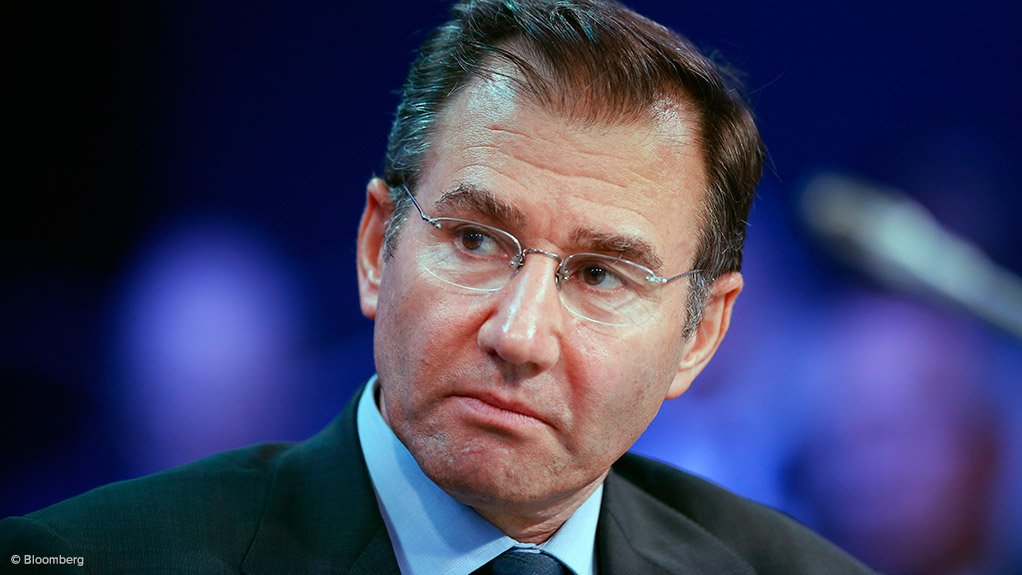Upbeat Glencore’s share buyback kicks off to analyst adulation
JOHANNESBURG (miningweekly.com) – Upbeat diversified miner and marketer Glencore, which declared an 11% higher dividend for the six months to June 30 on the back of above-consensus half-year results, has put a $1-billion share buyback programme under starter’s orders, which has evinced mining analyst adulation.
Glencore's shares rose on both the LSE and the JSE soon after the company published its latest set of results on Wednesday, when the board of the London-, Hong Kong- and now also Johannesburg-listed Glencore declared an interim distribution of $0.06 a share, which is 11% up on the 2013 interim distribution.
The company, headed by South African-born CEO Ivan Glasenberg, has now returned more to the market than the $7.9-billion it raised at its initial public offering.
“Finally, someone is listening to shareholders,” Barclays mining analysts headlined, as JP Morgan Cazenove applauded Glencore’s marketing performance in metals and minerals and agriculture, which more than offset the company’s disappointing energy earnings of $227-million before interest and tax, compared with agriculture’s $473-million.
“Key is the share buyback commitment and Glencore is the first of the diversifieds to make such a firm commitment,” said Investec Securities in a note.
“The announcement of a buyback is refreshing,” BMO Capital Markets analysts commented.
"Glencore proved with its dividend and buyback announcement that shareholders are high priority," said Jefferies mining analysts.
Morgan Stanley, which calculated that the half-year results were 3% above consensus, described the interim dividend as encouraging and the buyback as a strength signal, while Citi said it was likely to be welcomed by the market.
Liberum Capital, however, described Glencore’s net income of $2.01-billion - compared with consensus of $1.95-billion - as “small”, and used the same adjective to describe the buyback, which it put at 1.3% of current market capitalisation.
Liberum added that, while the buyback announcement might appease some - against the background of BHP Billiton’s share falling the day before on the absence of an expected buyback announcement - its diminutive size might disappoint others.
On suggestions that the $1-billion buyback was inadequate, Glasenberg said it actually totalled $1.7-billion as the company had last month bought back nearly $700-million of its convertible bond.
Taken with an increased dividend, the amount returned to shareholders was more like $2-billion.
After doing acquisitions and brownfields expansions, the company was still left with cash and the share buyback was seen as good value for the shareholders.
"We are very happy for the company to kick out cash and create value for its shareholders", Glasenberg added.
Expansionary capital expenditure (capex) commitments would come to an end in 2015, after which there would be only sustaining capex of some $3.5-billion to $4-billion a year and, even if commodity prices weakened, Glencore would continue to generate cash.
"If we keep generating cash and we don't have other acquisitions or brownfields expansions, we'll continue doing share buybacks. This is not the last and we intend to keep doing it in the future as long as we're generating cash and the funds are available," Glasenberg said.
Glencore CFO Steven Kalmin added that, given the daily liquidity of share sales in the market, even a R1-billion share buyback programme would take up to March next year to complete.
It was likely that the programme would continue when the company announced its full-year results early next year, with ongoing share buyback underpinning earnings-per-share accretion and price-earnings multiples.
Glencore's owner-management team benefited from share buybacks, which reduced the number of shares in issue and increased the proportion of shares held by individual members.
"They were happy just to increase their stake in the company," Glasenberg explained during a media conference that was dominated by share-buyback questions.
On holding the bought-back shares in treasury rather than cancelling them, Kalmin said both practices increased the proportion of ownership of all shareholders but the treasury option would prove cheaper and more efficient should the company one day re-issue the shares for acquisitions or employee compensation.
He added that it was more common than not for companies to keep the bought-back shares in treasury until it was perceived that over accumulation occurred.
"You can use those shares for acquisitions or you can cancel them and just reissue new equity in the future, which has the same effect," Kalmin explained.
Glencore’s half-year results were buoyed by marketing growth, overall production expansion and synergies from the acquisitions of Xstrata and agricultural subsidiary Viterra.
Earnings before interest, tax, depreciation and amortisation of $6.5-billion were up 8% and operational cash flow generation up 15% on the same period in 2013.
Net debt was $37.6-billion and there is more than $9-billion of available liquidity.
Glencore remains the most diversified natural resources company by activity, commodity and geography and is optimistic about the future, against the background of demand for its commodities being many times stronger than during the supercycle era and prices generally firming in the six months to June 30, led by nickel.
Glasenberg cited achieving nameplate capacity production at the recently expanded Mutanda copper mine in the Democratic Republic of Congo and strong low-cost growth in Australian thermal coal production as particular half-year highlights.
He said he expected supply of nickel and zinc, whose prices have risen by 35% and 10%, to decrease in absolute terms and other commodities to lift, with the probable exception being iron-ore, where supply growth was not expected to peak until 2017.
Glencore expects an effective tax rate in the range of 20% to 25% in 2014.
Copper Outlook
Glencore said that tight cathode market conditions were a key feature of the first half with supply disruptions and continued demand strength generating a deficit that was supported by a reduction in exchange stocks to levels last seen in late 2008.
Despite this, copper prices fell 8% to average $6 916/t, partly under the unfounded influence of a flood of metal from the unwinding of Chinese collateralised financing deals.
The actual outcome was quite the opposite, with cumulative Chinese net imports of refined cathode surging almost 50% higher period-on-period. Despite some of the more bearish expectations around the impact of slowing Chinese economic growth on base metals demand, the base effect on the scale of copper consumption growth, should see Chinese copper demand exceed 10-million tons in 2014, on the back of targeted gross domestic product growth of 7.5%.
Compared with mine supply disruptions of more than 650 000 t in 2013, unexpected disruptions have already trimmed more than 500 000 t from 2014 mine supply forecasts.
Mirroring the shortages of scrap and associated constraints on supply growth, exchange inventories have more than halved to total 251 000 t at the end of June.
Average zinc prices rose 6%, driven by a looming mine supply shortage, which is expected to affect the market in 2015 and more nickel was consumed than in the half year of the comparable period.
Indonesia’s ban on unprocessed mineral exports has put more than 300 000 t of primary nickel production at risk, mainly in the form of Chinese nickel pig iron. If sustained, the export ban will have a material impact on global nickel supply in the medium term, with sizeable primary nickel deficits forecast to arise.
Ferroalloys Outlook
There was a divergence in regional ferrochrome pricing during the first half of 2014, as a strong uptick in consumption in the West contrasted with relatively weaker demand conditions in China.
With global production largely unchanged on last year’s levels, prices increased steadily in all major stainless producing regions, except China.
Manganese alloy prices continued to move in a narrow range as supply kept pace with demand and vanadium prices remained similarly range bound during the period, as much anticipated production out of Australia hit further delays, while new Brazilian production was pushed into the second half of this year.
Aluminium Outlook
Average prices for alumina and aluminium fell 3% and 9% compared with the first half of 2013.
However, aluminium premiums for duty unpaid, in-warehouse material rose from a range of $210/t to $230/t at the end of 2013 to a range of $340/t to $360/t to June 30.
Iron Ore
The iron-ore market moved into surplus and inventories started to increase in China, resulting in free-on-board iron-ore prices decreasing from $130/t to below $100/t. As prices decreased, premiums also eroded which resulted in challenging marketing conditions.
Comments
Press Office
Announcements
What's On
Subscribe to improve your user experience...
Option 1 (equivalent of R125 a month):
Receive a weekly copy of Creamer Media's Engineering News & Mining Weekly magazine
(print copy for those in South Africa and e-magazine for those outside of South Africa)
Receive daily email newsletters
Access to full search results
Access archive of magazine back copies
Access to Projects in Progress
Access to ONE Research Report of your choice in PDF format
Option 2 (equivalent of R375 a month):
All benefits from Option 1
PLUS
Access to Creamer Media's Research Channel Africa for ALL Research Reports, in PDF format, on various industrial and mining sectors
including Electricity; Water; Energy Transition; Hydrogen; Roads, Rail and Ports; Coal; Gold; Platinum; Battery Metals; etc.
Already a subscriber?
Forgotten your password?
Receive weekly copy of Creamer Media's Engineering News & Mining Weekly magazine (print copy for those in South Africa and e-magazine for those outside of South Africa)
➕
Recieve daily email newsletters
➕
Access to full search results
➕
Access archive of magazine back copies
➕
Access to Projects in Progress
➕
Access to ONE Research Report of your choice in PDF format
RESEARCH CHANNEL AFRICA
R4500 (equivalent of R375 a month)
SUBSCRIBEAll benefits from Option 1
➕
Access to Creamer Media's Research Channel Africa for ALL Research Reports on various industrial and mining sectors, in PDF format, including on:
Electricity
➕
Water
➕
Energy Transition
➕
Hydrogen
➕
Roads, Rail and Ports
➕
Coal
➕
Gold
➕
Platinum
➕
Battery Metals
➕
etc.
Receive all benefits from Option 1 or Option 2 delivered to numerous people at your company
➕
Multiple User names and Passwords for simultaneous log-ins
➕
Intranet integration access to all in your organisation




















